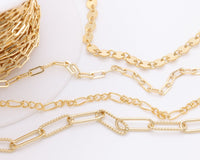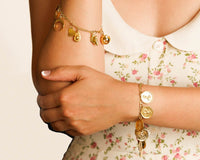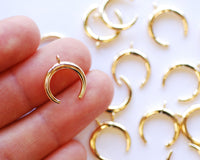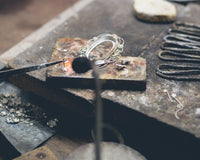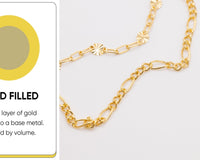How to Use Jewelry Wire
By: Leslie H.
Among the many materials used in jewelry making, jewelry wire holds a special place. Its versatility, availability in various metals and gauges, and the ease with which it can be manipulated make it a favorite among jewelers. Whether you're just starting out or looking to expand your jewelry-making skills, understanding how to use jewelry wire can elevate inspire new creations.
Jewelry wire comes in a wide range of materials, including sterling silver, gold-filled, copper, brass, and aluminum. Each material has its own properties, such as color, malleability, and strength, which can affect the final look and feel of your piece.
Wire Sizes and Gauges
Wire is measured in gauges, which indicate its thickness. Lower gauge numbers mean thicker wires, which are sturdier but harder to bend, while higher numbers indicate thinner, more flexible wires.
- 12 Gauge (2.05 mm): Very thick and sturdy, ideal for making frames and structures that need to hold their shape, such as cuff bracelets and chokers.
- 14 Gauge (1.63 mm): Slightly more flexible than 12 gauge, but still very strong. Great for clasps, bangles, and ring bands.
- 16 Gauge (1.29 mm): Offers a good balance between strength and malleability. Suitable for jump rings, clasps, and lightweight bracelet frames.
- 18 Gauge (1.02 mm): A versatile wire that can be used for making structural pieces like earring posts and lightweight frames, as well as for wire wrapping beads.
- 20 Gauge (0.81 mm): One of the most popular sizes, it's thick enough for ear wires, jump rings, and lightweight clasps, while still being flexible for some wire wrapping techniques.
- 22 Gauge (0.64 mm): The go-to gauge for wire wrapping, including wrapping stones without holes, making wrapped links, and creating detailed wire embellishments.
- 24 Gauge (0.51 mm): Ideal for detailed wire wrapping, weaving, and working with small beads. It's flexible and easy to manipulate but can hold its shape in intricate designs.
- 26 Gauge (0.41 mm): Excellent for fine wire weaving, wrapping small stones, and making delicate jewelry components. It's very flexible and suitable for intricate designs.
- 28 Gauge (0.32 mm): Extremely thin and flexible, best used for very detailed wire work, such as coiling, weaving, and knitting. It's perfect for adding fine details to jewelry pieces.
- 30 Gauge (0.25 mm) and beyond: These ultra-thin wires are primarily used in advanced wire weaving, crocheting, and knitting jewelry. They allow for a high level of detail and delicacy but require a gentle touch as they can break more easily than thicker wires.
Types of Jewelry Wire
Round Wire: The most versatile and commonly used wire shape, ideal for making loops, wraps, and other components.
Square Wire: Offers a contemporary look and is perfect for creating structured designs. It can also be twisted to add texture.
Half-Round Wire: Flat on one side and rounded on the other, it's often used for wire wrapping and securing components together due to its ability to lie flat against surfaces.
Tips for Using Jewelry Wire
Choosing the Right Wire: Consider the project you're working on. Use thicker, lower gauge wire for structural components like clasps and bangles, and thinner wire for delicate wrapping and detailing.
Tools Are Key: Invest in quality tools such as wire cutters, round-nose pliers, flat-nose pliers, and a wire straightener. Proper tools make manipulation easier and can help prevent damage to the wire.
Practice Makes Perfect: Wire wrapping and bending require practice. Start with copper or aluminum wire, which are more affordable and easier to manipulate, before moving on to more expensive materials.
Experiment with Textures: Use hammers and anvils to flatten or texture your wire for unique effects. Be mindful of the wire's hardness; work-hardening can occur, making the wire more brittle.
Understanding Hardness: Wires come in different hardness levels: dead soft, half-hard, and full-hard. Dead soft is easiest to shape, making it ideal for intricate designs, while half-hard and full-hard provide more structure and support.
Project Ideas to Get You Started
Wire-Wrapped Stones: Use thin, flexible wire to wrap around stones or crystals, creating pendants or earrings.
Bangles and Bracelets: Use thicker gauge wire to form the base of a bangle or bracelet, then embellish with smaller gauge wire or beads.
Earrings: Experiment with different wire shapes to create hoops, dangles, or geometric designs. Add beads or charms for extra flair.
Rings: Use a mandrel to shape your wire into rings. Embellish with wire-wrapped gems or intricate wire patterns.
Jewelry wire is a fundamental component of many jewelry designs, offering a blend of strength, beauty, and versatility. By understanding the types of wire available and mastering the basics of wire manipulation, you can unlock a world of creativity in your jewelry-making projects. Don't be afraid to experiment with different materials and techniques, and remember, the beauty of handmade jewelry lies in the personal touch and uniqueness of each piece. Happy crafting!
Starting with a 20 gauge copper wire can offer a good balance between flexibility and strength, making it versatile for various projects.
How do I prevent my wire from hardening and breaking?
Wire hardens as it's worked (bent, twisted, etc.), which can lead to breaking if overworked. To prevent this, work with the wire as gently as possible and use nylon jaw pliers to straighten and smooth your wire without adding extra work-hardening. If the wire becomes too hard during manipulation, you can use a process called annealing (for certain metals like copper, silver, and gold) to soften it again, though this requires specific equipment and safety precautions.
What's the difference between dead soft and half-hard wire?
The terms "dead soft" and "half-hard" refer to the hardness or temper of the wire. Dead soft wire is very malleable and easy to bend, making it ideal for intricate designs and wire wrapping. Half-hard wire has been work-hardened slightly, making it stiffer and better suited for creating structures and components that need to hold their shape. Your choice depends on the requirements of your project.
Can I mix different types of wire in a single project?
Absolutely! Mixing different types of wire (in terms of metal, gauge, and hardness) can add depth, contrast, and interest to your jewelry pieces. Just be mindful of the properties of each type of wire you're using and how they interact. For instance, using a thicker, sturdier wire for the frame of a piece and a thinner, more flexible wire for wrapping can yield excellent results.
How do I choose the right gauge wire for my project?
The choice of gauge depends on the specific needs of your project. Thicker wires (lower gauge numbers) are better for structural components like clasps, frames, and bangles, while thinner wires (higher gauge numbers) are ideal for wire wrapping and detailed work. Consider what the wire needs to do in your piece (support weight, be flexible, etc.) and choose accordingly. Feel free to refer to the gauge thickness chart above.
How do I cut jewelry wire without damaging it?
Use flush cutters designed for jewelry making to cut wire. These cutters give a clean, close cut without squashing the wire. Always cut with the flat side of the cutters toward your work to ensure a neat finish, and protect your eyes with safety glasses, as cut wire ends can fly off unexpectedly.










